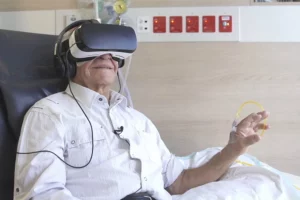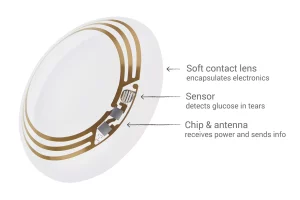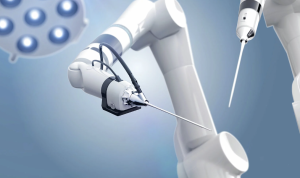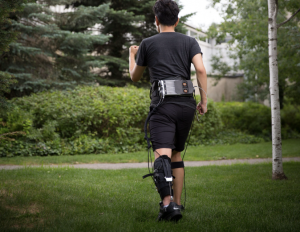How Cutting-Edge Innovations are Redefining Healthcare
In the rapidly evolving healthcare landscape, technological advancements are pivotal in transforming patient care, diagnosis, and treatment. The convergence of various disciplines, such as virtual reality (VR), neurostimulation, smart contact lenses, artificial intelligence (AI), biosensors, medical robots, and surgical robots, has paved the way for groundbreaking innovations that were once science fiction. These innovations are enhancing the capabilities of healthcare professionals and empowering patients to take control of their well-being like never before.
Virtual Reality (VR) and Immersive Healthcare

Credit: News Atlas
One of the most captivating technological leaps in healthcare has been the integration of virtual reality. VR is no longer confined to entertainment; it has transcended to revolutionize medical training, patient rehabilitation, and even pain management. For instance, medical students can now delve into immersive VR simulations that replicate complex surgeries, enabling them to refine their skills in a risk-free environment. Moreover, patients undergoing painful procedures can find solace in VR distraction therapy, which immerses them in a soothing virtual environment, effectively alleviating pain and anxiety.
Neurostimulation for Enhanced Well-being
Neurostimulation, a field involving electrical or electromagnetic impulses to specific neural targets, has garnered significant attention for its potential to treat neurological disorders and enhance overall well-being. Recent breakthroughs have showcased the use of neurostimulation to tackle conditions such as Parkinson’s disease, depression, and chronic pain. Research conducted at renowned universities like Stanford and Harvard has led to the development of advanced deep brain stimulation techniques tailored to individual patients, providing targeted relief and minimizing side effects.
Smart Contact Lenses: Merging Vision with Technology

Credit: Vox
Smart contact lenses, equipped with miniature biosensors, have opened new vistas in healthcare monitoring. These lenses can continuously track glucose levels in tears, offering a non-invasive solution for diabetic patients who previously had to endure painful finger pricks. Additionally, these lenses can monitor intraocular pressure, a crucial factor in managing glaucoma, and provide real-time data to both patients and physicians. Integrating AI algorithms in these lenses further enhances their capabilities by detecting patterns and predicting potential health issues, enabling proactive intervention.
AI-Powered Predictive Insights and Personalized Medicine
Artificial Intelligence has become an indispensable tool in healthcare, providing physicians with predictive insights and enabling personalized treatment plans. By analyzing vast amounts of patient data, AI algorithms can identify trends and patterns that human doctors might miss. This enables early detection of diseases, more accurate diagnoses, and tailored treatment recommendations. For instance, the collaboration between the Mayo Clinic and IBM Watson has led to the development of an AI-powered tool that assists physicians in diagnosing and treating complex medical cases with unprecedented accuracy.
Biosensors, Medical Robots, and Surgical Robots

Credit: Faulhaber
Integrating biosensors in medical devices has created wearables that monitor vital signs, detect irregularities, and transmit data to healthcare providers in real-time. This technology enables remote patient monitoring, timely interventions, and a more comprehensive understanding of individual health trends.
On another front, medical robots and surgical robots are transforming the surgery landscape. The da Vinci Surgical System, pioneered by Intuitive Surgical, allows surgeons to perform intricate procedures with enhanced precision, smaller incisions, and reduced recovery times. Researchers at institutions like MIT are exploring soft robotics for delicate surgeries, promising even more significant advancements in this field.
Universities Paving the Way for Future Innovations

Credit: Wyss Institute -Harvard University
Leading universities worldwide are actively engaged in research, pushing healthcare innovation’s boundaries. For Instance, the Wyss Institute for Biologically Inspired Engineering at Harvard University works on bioinspired soft exosuits to aid mobility for patients with movement impairments. Stanford University’s Bio-X program drives interdisciplinary research in biosensors and personalized medicine. These academic initiatives foster collaboration between various disciplines and ensure that the next generation of healthcare technologies is poised to elevate patient care to unprecedented heights.
Conclusion
In conclusion, the amalgamation of virtual reality, neurostimulation, smart contact lenses, artificial intelligence, biosensors, medical robots, and surgical robots is ushering in a new era of healthcare. These cutting-edge innovations are transforming the way healthcare professionals operate and empowering patients to participate in their well-being. As universities continue to delve into groundbreaking research, the trajectory of healthcare technology promises even more remarkable advancements, making the future of healthcare an exciting and promising frontier.

